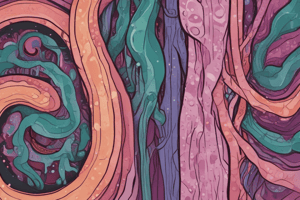Podcast
Questions and Answers
What is a characteristic feature of the lesions observed in ulcerative colitis?
What is a characteristic feature of the lesions observed in ulcerative colitis?
- They present as skip lesions.
- They affect contiguous sections of the colon. (correct)
- They are not associated with pseudopolyps.
- They involve thickening of the bowel wall.
Which of the following microscopic features is unique to ulcerative colitis?
Which of the following microscopic features is unique to ulcerative colitis?
- Crypt abscesses are observed. (correct)
- Granulomas are present.
- Pseudopolyps do not occur.
- Mucosal inflammatory infiltrates are abundant. (correct)
What is a common trigger for exacerbations of ulcerative colitis?
What is a common trigger for exacerbations of ulcerative colitis?
- Certain medications
- Chronic infections
- Genetic mutations
- Stress (correct)
Which additional condition may occur in patients with ulcerative colitis?
Which additional condition may occur in patients with ulcerative colitis?
Which of the following features is not typically associated with ulcerative colitis?
Which of the following features is not typically associated with ulcerative colitis?
What is the primary concern regarding dysplastic changes in the epithelium in ulcerative colitis?
What is the primary concern regarding dysplastic changes in the epithelium in ulcerative colitis?
Which of the following statements describes a distinction between ulcerative colitis and Crohn's disease?
Which of the following statements describes a distinction between ulcerative colitis and Crohn's disease?
Which of the following is not a characteristic finding in the colon during a diagnosis of ulcerative colitis?
Which of the following is not a characteristic finding in the colon during a diagnosis of ulcerative colitis?
Flashcards are hidden until you start studying
Study Notes
Morphology
- Affects the colon and rectum, specifically showing continuous lesions.
- Skip lesions, which are typical in Crohn's disease, are absent in ulcerative colitis.
- Long-standing disease may lead to pseudopolyps, small bulges formed by regenerating mucosa.
- The bowel wall remains non-thickened and there is no inflammation of the serosa.
- Microscopic changes include alterations in crypt architecture, with neutrophils damaging the epithelium.
- Crypt abscesses form due to clusters of neutrophils within the crypts.
- Inflammatory infiltrates consist of lymphocytes, plasma cells, and macrophages, primarily affecting the mucosa and submucosa.
- Characteristic features include basal plasmacytosis and possible loss of goblet cells with mucin depletion.
- Late-stage conditions may show mucosal atrophy and common Paneth cell metaplasia.
- Dysplastic epithelial changes can progress to carcinoma.
Clinical Features
- Primarily occurs in younger individuals with stress as a common trigger.
- Characterized by cycles of exacerbations and remissions.
- Notable clinical symptom includes bloody diarrhea.
Extraintestinal Manifestations
- Inflammatory arthritis may occur as a complication.
- Dyllitis, or inflammation of the eyes, is also a possible manifestation.
Distinguishing Features Between Ulcerative Colitis and Crohn Disease
-
Site: Ulcerative colitis is limited to the colon and rectum, while Crohn's disease can affect the entire GI tract from mouth to anus.
-
Lesion Distribution: Ulcerative colitis presents continuous lesions; Crohn's disease features skip lesions.
-
Inflammatory Infiltrates: Ulcerative colitis involves mucosal inflammation compared to transmural inflammation in Crohn's disease.
-
Granulomas: Granulomas are absent in ulcerative colitis but present in Crohn's disease.
-
Crypt Abscesses: Both conditions show crypt abscesses.
-
Pseudopolyps: Both diseases can lead to pseudopolyps, indicating regeneration.
-
Strictures: Strictures are uncommon in ulcerative colitis, while they are frequent in Crohn's disease.
-
Fistulas: Formation of fistulas is rare in ulcerative colitis but prevalent in Crohn's disease.
-
Diagnosis often requires both clinical assessment and endoscopic evaluation due to significant overlap between the two conditions.
Studying That Suits You
Use AI to generate personalized quizzes and flashcards to suit your learning preferences.




